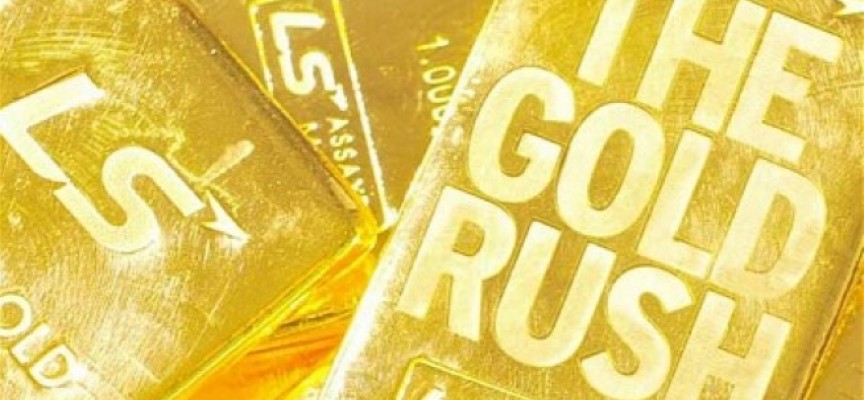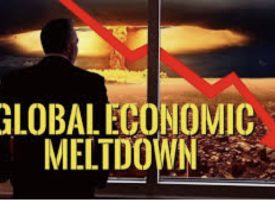Today a man who is connected in China at the highest levels discussed the next SuperCycle, the great inflation and where the price of gold is headed.
May 13 (King World News) – John Ing: Bull markets climb walls of worries, defying today geopolitical tensions, rising interest rates, record levels of debt and a worsening third coronavirus wave. Stimulus checks sent to consumers have fueled US markets to climb to record levels underpinned by the Federal Reserve’s “magical money tree (MMT).
Interest rates earlier had fallen to 300-year lows but bounced 100 basis points recently on expectations that the vaccine rollouts and waves of central bank fiscal stimulus would spark the biggest economic boom in history. The latest quarter was one of the wildest in stock market history with the Dow Jones smashing through 34,000 as the US economy rose 6.4 percent close to pre- pandemic levels. Although, the world economy contracted 3.3 percent in the pandemic-hit 2020, the global economy will grow by 7 percent in 2021 in a “Roaring Twenties” redux. Investors are ignoring the sky-high valuations, instead celebrating the “sugar high” of stimuli and the belief that inflation is dead. Ironically what lies ahead is a change in inflationary psychology, as a prelude to the Great Inflation.
Amid the fastest growth projections in 40 years, a dovish Fed promised to keep rates close to zero until at least 2024, despite the likelihood of inflation overshooting the Fed’s long run inflation target of 2 percent. The Fed keeps stoking the inflationary fires, adding $3 trillion to a balance sheet that topped $8 trillion, up from $150 billion in 2008. Meantime, the government believes that they can keep spending with a budget deficit surging to an all-time high of $1.7 trillion or almost double the previous record. And all manner of spending by the Biden government of almost 25 percent of GDP, remakes big government to reach every corner of America. The United States has become addicted to spending, and debt. A trillion here, a trillion there and pretty soon we will be talking about real money…
One of the top performing silver stocks in the world! To learn about the
opportunity in SilverCrest Metals click here or on the image below
The Era of Nonstop Stimulus
Between 2010 and 2014, the Fed bought almost 40 percent of the extra debt issuances by the government, doubling its Treasury ownership to almost 20 percent becoming the largest bond player in the world. Lately, the government has purchased more than half of the issuances to make up for the lack of foreign buying, augmenting their $120 billion a month purchases of government debt. To date, the Fed owns almost 18% of all outstanding Treasury issuances, monetizing America’s debt. It does not help that at the same time, the US current account deficit has widened as spending on imports grows further, aggravating the imbalance.
While rising yields tests the Fed’s promise to keep the monetary reins loose, the “everything rally” carried the markets to daily record highs, further widening a wealth gap with 16 million Americans still on government assistance. As the large economies recover from the pandemic, the resultant economic boom underestimates the ensuing risks of a new era of higher inflation and real interest rates. Of concern is the cost, while staggering is not the only problem or even the biggest problem. Policymakers will be forced eventually to slam on the monetary brakes, which would generate a massive debt crisis and implosion of liquidity. America is stepping into an abyss.
Yet some are non-plussed believing that because we have emerged unscathed from the worst pandemic in a century, which shutdown businesses, grounded airlines and sent global economies into a tailspin, our indebtedness doesn’t matter. Credit would go to the unprecedented global government spending and public sector deficits that represented anywhere from 15 precent to 25 percent of GDP. While there never in history been as much liquidity pumped into an economy and markets, the biggest risk is the withdrawal of that liquidity, not by a central bank, but by an implosion or bursting of the liquidity bubble, premised on the erroneous belief that today’s low interest rates will last forever.
And at some point, a central banker might ask, how is the nation to pay for all this, particularly since the bill keeps getting bigger? Sooner or later the bill must be paid. To not do so, raises the fate of another central banker, Mr. Naci Agbal, the Turkish central bank governor appointed in November, who after lifting interest rates to combat inflation was fired by President Erdogan, making him the third Turkish central bank governor in less than two years. His crime? Agbal dared to raise interest rates to 19 percent to combat 16 percent inflation and a plunging lira.
The Never Normal
America’s spending and rising red ink has already exceeded peacetime records set under Mr. Trump who ended his term with a debt to GDP of 100 percent and a budgetary deficit at 15 percent of GDP. After Biden’s “Go Big” government spending, debt to GDP will hit 115 percent this year as his government proceeds to “nationalize” the American economy. For the past decade, central bankers have embarked on experimental measures such as quantitative easing (QE) a.k.a helicopter money, and today under modern monetary theory (MMT), the result is a record accumulation of debt, leaving future generations with the bill. Alternatively, the multitrillion dollar economic cost could be paid with more borrowed money or a hike in taxes or cuts in spending. However, since reduced spending is a nonstarter, the logic is to get the rich and Wall Street to pay…
Dire Warning For Global Financial System
To hear Steven Dean’s dire warning for the global financial system and also his discussion of the Gold & Silver markets CLICK HERE OR ON THE IMAGE BELOW.
But Congress is divided, forcing Mr. Biden to rely on a razor thin majority in each chamber to soak the rich, of which some are Democrats. Although higher taxes might bring in $700 billion, it is not enough to pay for Mr. Biden’s multitrillion spending agenda. We believe to prevent this house of cards from collapsing, higher inflation is needed, a painful and obvious choice since more borrowings increases pressure on interest rates. However, a return to normalized rates of the past between 4 percent to 6 percent is unlikely, because an uptick would hurt a significant part of the populations’ wealth, triggering waves of bankruptcies because our financial markets are much more leveraged and exposed than in the 2008 financial crisis.
To be sure, America’s insatiable appetite for funding its multitrillion dollar spending programmes has pushed Treasury Secretary Yellen to look for ways to finance Mr. Biden’s whopping triple spending package of a $2.3 trillion infrastructure plan, $1.5 trillion America Families Plan and $1.8 trillion Education Plan, even calling for a global tax regime so that other countries could push up their tax rates as well as a digital tax. To make America’s higher tax rate competitive, a global minimum tax and digital tax would prevent companies from seeking lower taxed jurisdictions. Yet a global minimum tax opens the door to a labyrinth of corporate taxation which would penalize US tech giants and other large multinationals. Since higher taxes would be taken out of the private sector’s ability to consume or invest, it shifts the cost to consumers which is inflationary. America is leading a global tax race to the top because even money printing has its limits. Left unsaid is US taxation alone funds only 50 percent of the total US budget deficit. Taxes are inflationary.
The concern and one of the reasons the Turkish central banker had to fall on his sword is that inflation and interest rates were rising due to the deficit financing programmes. With debt piling up every year, governments seem to be pushing on a string, and their addiction to debt requires ever larger programmes. And now, Mr. Biden is doubling down on his 100-day agenda including a multitrillion dollar infrastructure and family social safety net, only weeks after passing the $1.9 trillion American Rescue Plan. Hailed as a FDR-type “New Deal”, the ambitious plan both broadens government’s reach into a greener economy and social policy, yet has little to do with COVID-19. America has fallen into a debt trap.
While Mr. Biden hopes to make the rich pay through tax increases, even an enlarged capital gains tax must be supported by a divided and “woke” Congress, including his own party. Mr. Biden and Mr. Powell will soon discover, like the firing of Turkish central banker Mr. Agbal, that using the printing presses has its limitations and is not the solution to paying back all that debt.
America, the Bubble
As a result, the supersized fiscal stimulus has fueled froth and excessive risk-taking causing a distortion in asset prices, inflating a series of bubbles. Today, the stock market is in a bubble, credit markets are in a bubble, the crypto markets are in a bubble, commodities are in a bubble and now crypto-art is in a bubble. History shows from Dutch tulips to dot.com, bubbles always burst. What is not yet in a bubble is inflation, partly because the governments’ measurement of CPI inflation as a proxy for prices is flawed.
Take the actual Consumer Price Index (CPI) measurement which has been adjusted numerous times and rather than reflect the price of the usual combination of goods and services, the CPI no longer reflects household spending patterns, such as digital spending, food takeout or even housing prices. Food and energy were earlier stripped from core inflation because they were considered too volatile. Today, the largest item for households is housing, which rose 11 percent in the past 12 months, but that too was excluded because a home is considered an investment, not shelter. Instead, an implied rent proxy for owner-occupied housing is used to measure cost of shelter which makes up about a third of the CPI basket…
To hear Sean Boyd discuss $3,000 gold and the big game-changer
for the gold market CLICK HERE OR ON THE IMAGE BELOW.
Yet, March producer prices, a forerunner of core inflation is up 1 percent and that can’t be distorted. Thus, while the Fed downplays inflation believing it transitory or a “blip”, US consumer prices actually spiked to 4.2 percent in March, the highest in 9 years. Crop prices for corn, soybeans and wheat have hit decade old highs, spurred by Chinese demand. What gives concern is that our central bankers, regulators and investors base their decisions on this flawed and outdated measurement device.
The Great Unwind
Now with cooped up consumers and companies flush with cash, households hold $2 trillion in savings and corporate America carries $3 trillion on their balance sheets, due principally to the largesse of the American government. With the foundation poured as consumers go on a celebratory spending spree, US households’ exposure to stocks is at 41 percent, the highest ever. Instead of holding money, because interest rates are too low the general public is now willing to leverage their wealth into high-risk securities, anticipating a “Roaring Twenties-type” economic boom, the mother of all booms.
Of concern is that sentiment indicators have surpassed the highest levels of 2007 and 1999, when extreme periods of euphoria were followed by market crashes. As in the “Roaring Twenties” scenario, stock markets are again at record highs, with the froth and speculation helping stay-at- home traders to make buckets of money, turbo-charged by social media and commission-free trading platforms. With “stimmie” checks in hand and lacking the memories of the stomach- churning losses of 2008, the FOMO Gen Z-ers (ages 9 to 24) traders have helped create new markets and new fads, turning the capital markets into the world’s biggest casino.
With financial markets in a frenzy, valuations have reached new heights, higher that the 1920s stock boom as a flood of cheap cash searches for the next big winner. This time money is free and nothing is more fashionable today than wild speculation because of the belief that there is no or little risk. The explosion in trading has lifted all boats.
Moreover, riding on the herd of new traders, retail platform Robinhood needed a $3.4 billion bailout after its clients borrowed billions to trade GameStop, a digital trader. Then, as a sign that markets are littered with unstable excesses like margin debt, hedge fund Archegos Capital was forced into a whopping $30 billion fire sale as margin calls unwound its derivative “total return swaps” position, leaving the big global banks like Nomura Holdings, UBS and Credit Suisse holding the bag with $10 billion of outsized losses in what might prove to be the biggest loss in history. Similarly, the scramble for the exits among the banks to limit their losses deepened the losses as liquidity imploded following the failure of Greensill, the eponymous supply chain finance company which too imploded when securitised debt funding disappeared. In China, the rumoured bankruptcy of Huarong is sending ripples through the bond market. To date, the system has held up under these strains, but for how long?
The collapses have revived whether the dash for growth prompted Archegos, Huarong, and Greensill to embrace more risk, and as microcosms of the market used cheap funding and leverage to invest in stocks, which went ever higher, leveraging their paper profits to buy even more. The debacles bear a remarkable resemblance to the 2008-2009 financial implosion when capital was wiped out overnight by overleveraged derivatives. History shows that when bubbles burst, liquidity and the “greater fools” quickly disappear. For now, markets are taking the world’s biggest trading loss as a one-off isolated event, but that may change. Bigger bubbles are inflating, the crypto bubble…
Billionaire Eric Sprott bought a 20% stake in a mining company
to find out which one click here or on the image below

That Seventies Show
We believe that inflationary pressures lie close to the surface due to the expansionary monetary policies that go back decades. Congress has passed eight stimulus programmes that more than replaced lost government revenues and provided subsidized income for millions of Americans. All this casts doubt on the need for Bidenomics to pass the largest ever public works program, the $2.3 trillion American Jobs Plan infrastructure bill that combined with earlier packages amount to nearly a quarter of US GDP. Mr. Biden’s spending is reminiscent of FDR’s “New Deal” or the Seventies’ Great Inflation when Lyndon B. Johnson’s spending for his “Great Society” and the Vietnam War sparked America’s double digit near-hyperinflation. This time, Mr. Biden’s FDR- sized reboot falls again on the Federal Reserve to finance and while the near-term effect was yet another boost to richly valued stock prices, the boost widens the disconnect between fiction and reality. Also, Mr. Biden’s $6 trillion overhaul of America is a temporary but crude attempt to wrest control of Congress ahead of the midterms next year.
And, looking back, an innocuous event was believed to have sparked the near hyperinflation conditions in 1972, when the anchovies went missing off the cost of Peru due to El Nino. Anchovies were an important protein supplement and Japan, then the second largest economy in the world purchased supplies of soybeans as a substitute. Since US farmers produced 70 percent of the world’s supply, prices skyrocketed, triggering President Nixon to impose a soybean embargo in 1973. Also, an OPEC oil embargo and unprecedented weather saw these seemingly unrelated events to be the catalyst for double-digit inflation.
Now, with too many dollars chasing too few goods, primed by trillions of stimulus payments, we believe we are facing a repeat of the Seventies-type “Great Inflation” when the heady spending of President Johnson’s “guns and butter” led to 14.5 percent inflation, 18.4 percent mortgages and 7.4 percent unemployment. And half a century later, the Federal Reserve is replaying history resulting in skyrocketing debt and bubbles everywhere, and the rekindling of inflation. And as before, investors are switching wealth into so-called “hard” assets like real estate, stocks and gold which tend to appreciate when inflation becomes a bigger risk in portfolios. Already once safe bonds have lost 13 percent this year, threatening the end of the 40-year bond bull market.
Today, the ocean of cash sloshing around the system could easily sink ships. A key difference with other expansionary periods of the past, is that the Fed’s purchases this time has boosted both bank reserves and monetary base, the feedstock of money. Inflation then and now is always a monetary phenomenon. Money expansion spiked in the past year, growing by a whopping 27 percent, the most ever. Year to date, money supply has already grown 25 percent. Money has become free and there is too much available. In the Seventies, policymakers seemed to have had bigger worries, until the economy and inflation exploded, needing Fed Chair Paul Volcker to rescue America by cutting back money supply to avoid hyperinflation. Today the global financial system has become increasingly interdependent and the “feedstock” of inflation has dwarfed past infusions. This time we won’t have Paul Volcker around to contain inflation.
The Next Supercycle
We can recall that neither the bond market, stock market or policymakers foresaw the Great Inflation and like then, warnings of higher inflation are being ignored, particularly by the central bank “inflation deniers”. As was the case fifty years ago when everyone thought the price moves were transitory, markets today are ignoring the obvious. We believe, the parallels between current conditions and then are striking and worrisome. Inflation is a dynamic animal.
There are other striking parallels. Prices are rising on everything from used cars to 2X4s. Supply chain disruptions for example, forced the car industry to cutback production due to a global chip shortage. As a result, car prices have increased. The 2021 French wine harvest is in peril due to a severe winter frost which threatened vineyards across France. The wines of Bordeaux will cost more. And amid the pandemic, there are shortages of hospital beds, PPE, vaccines and even the necessary ingredients to make the vaccine, which have crippled supplies. Supply chains already stretched by the pandemic itself has pushed up overall prices. Strong demand from China and infrastructure spending have lifted prices of many important raw materials in aluminum, copper, iron ore and lumber, fueling talk of a supercycle. Even the lowly pallet hit record highs, buoyed by the boom in e-commerce.
Bottlenecks also created chaos when one of the world’s largest container ships, Ever Given ran aground, blocking the Suez Canal which handles 10 percent of the world’s seaborne goods and similar amounts of oil. The blockage of a vital trade route caused a ripple effect spanning the globe as it disrupted global supply chains, exposing the fragility of tightly stretched supply chains. There are strains everywhere as the world’s supply for semiconductors disrupted earlier by pandemic- induced shortages, shutdown parts of the car industry because of the lack of chips to power everything from windows to brakes.
The global dearth of chips has governments belatedly planning a boost in domestic production for security purposes but that will take time and money. Intel recently approved plans to spend $2 billion to build just two new factories in Arizona but shortages will persist into 2022 reflecting decades of underinvestment. Taiwan Semiconductor Manufacturing Company (TSMC), the world’s largest chipmaker that controls more than 80 percent of the made-to-order market, warned of the continuation of shortages and price increases into 2022. The chip giant will invest $100 billion over three years to boost capacity.
Amid the current atmosphere of rising prices, there is also inflation in real estate, which is now the largest part of a homeowner’s wealth which recently reached near highs. According to Federal Reserve data, households ended 2020 with $14.1 trillion of combined chequing and savings, up from $11.4 trillion in 2019 due in part to the enormous influx of federal dollars and low interest rates. Home prices surged to 15-year highs increasing 11.2 percent from last January 1920, which is the highest rise since February 2006. Despite the pandemic, soaring demand was due more to the lack of inventory, according to the National Association of Realtors who noted there are only 1 million homes for sale. In fact, there are more real estate agents than homes currently for sale in the United States. Worrisome is that fueled by the lowest rates in 300 years, according to the IMF, credit to the private sector reached 160 percent, the highest since 2008, just before the last financial crash…
To learn about one of the most exciting silver plays in
the world click here or on the image below

A cold snap in Texas shutdown petrochemical plants of which some are still closed leading to strained supply chains, curtailing plastic production which caused polyethylene prices to skyrocket. Consumers are set to feel the bite from shortages, ranging from labour to rental cars to vaccines. Prices are heading higher. A crippling gas crisis hiked prices after hackers shutdown North America’s biggest pipeline. The question is whether these events are happenstance, temporary disruptions or a warning of the inflationary dangers ahead comparable to the Seventies, when a string of unrelated events created near-hyperinflation. Inflation is back, the obituaries were premature.
As COVID Abates, Geo-Political Risk Rises
And, of course the pandemic lingers as new variants hammers the global economy straining healthcare systems. As if the lessons of 2020 or the Thirties-type protectionism was not enough to teach us of the need for cooperation, Covid-19 has unleashed vaccine nationalism, particularly over the distribution of precious vaccines at a time of the third variant wave. We have a long way to go. The global response to Covid-19 and the vaccines has been fragmented with geopolitics and the financial aspects, colliding with the supply-chain of vaccines, produced by a handful of pharmaceutical companies. Populism still reigns. For example, the EU threatened export bans on the vaccines made in the EU, creating a backlash from other nations. Others have retaliated with bans of the needed elements or glass vials. With global supply chains, reciprocity issues have broken the chains. And as if we didn’t learn from the competition to secure ventilators and N95 masks, the EU and America have hogged domestic vaccines, undermining trust. Exports are problematic because the majority of vaccines are sourced in the United States, China, India and the EU.
America has taken an “America First” policy keeping production for itself despite surpluses. This lack of cooperation is a problem for all. Trust was further eroded when vaccine makers were told that their patents might be revoked or a waiving of certain patent protection, unless the companies delivered first on their production contracts domestically, which would set a bad precedent for future investment in new drugs. Meantime, COVID and its variants continue to spread because it does not respect sovereign borders. China and US have reached 200 million vaccine jabs. Vaccine nationalism is rife, the system of all for one, one for all, needs to be managed by the all, just as there is the need for openness and collaboration. A little help from friends would go a long way to contain this virus. Vaccine nationalism has led to vaccine diplomacy and countries like Russia and China have exported half of their production, gaining political influence in the process.
Beijing Bashing Hurts America Too
As in the Thucydides’ Trap, when an incumbent superpower and a rising one clashed, the historic record showed that the majority of the time, the clashes resulted in bloodshed. Coexistence has become increasingly difficult despite Mr. Biden’s promise of a new international approach to block China’s rise. The American-China Alaskan summit devolved into name calling, continuing a downward spiral in American-Sino relations. Meantime, a resurgence in cold war-like geopolitical tensions have heated up between Russia-Ukraine, Russia-US and the standoff with China continues. Believing that America is in decline, China and Russia have challenged America and its president. Central to Mr. Biden’s strategy is a more global response and references of a “rules- based” order. Yet in the competition for allies, his “quad” world order comprising of traditional allies, Australia, Japan and India appears to be more optics since it does not share military, economic or even political ground. Mr. Biden will find that not being Mr. Trump is enough to make America great again and, America’s pre-eminence can no longer be taken for granted.
Today China is the EU’s largest trading partner, replacing the United States as part of a decade long pivot away from the US. Europe’s appetite for medical equipment and electronics has grown during the pandemic with goods travelling through a trade corridor financed as part of China’s Belt and Road Initiative using euro/renminbi swaps. According to the US international Trade Commission, China accounted for almost 90 percent of American PPE demand, pre-pandemic. While federal grants boosted domestic supplies, noteworthy is that PPE imports are still 3X pre- pandemic levels. Then again Mr. Biden must somehow woo US businesses and Wall Street, who despite the government’s anti-China rhetoric are expanding their businesses in China to take advantage of the huge market and economy, which grew 18.3 percent in the first quarter due to booming exports and industrial growth…
To find out which silver company just made a major acquisition that will
quadruple their production click here or on the image below

None of this means that America can be complacent about its future any more than China can assume that their political stability is guaranteed. For too many times, America’s red lines have been crossed and is viewed by many as an unstable and untrustworthy partner. Also, America remains divided, in politics, governance and economic. The storming of Capital Hill and continuing mass shootings reinforces the picture that America is in decline. In the past half century, one-time access to America markets and consumers was a goal, but Trump’s tariffs, stiff immigration rules and the hogging of COVID-19 vaccines, make America an unreliable partner. China has countered, filling the vacuum with a vaccine diplomacy to go along with the Belt and Road Initiative and $3 trillion of reserves. China has become not only the shopkeeper but also the banker to the world. That role is particularly important because of the unified desire by its allies to lessen American financial hegemony.
Capital War
While Mr. Trump lost the trade war, Mr. Biden is set to lose another as he choses an adversarial approach rather than a cooperative one. America has become the world’s largest debtor and since China is the world’s largest creditor with over $1 trillion of American debt, China has yet to weaponize its financial might. However, if China refused to rollover US debt, only then would reality bite.
Moreover, Mr. Biden has introduced new sanctions and a 280-page China bill to counter China’s growing global influence. Since the global financial crisis, China has laid the groundwork for financial independence. The dependent? The United State’s reliance on China to finance US debt is at odds with America’s demonization of everything Chinese, particularly since the US and China are economically reliant on each other.
As an example, China has set up an alternative to the Belgium-based SWIFT ecosystem which provides the payment system for financial institutions but over the past decade has been weaponized by America. When the United States sanctioned Iran, it blocked Iranian institutions from using SWIFT to access US banking institutions, crippling Iran’s finances. Russian institutions have been thwarted with blocked access to SWIFT. China instead has quietly set up an alternative to America’s financial hegemon with a joint venture with SWIFT and four of its Chinese institutions to make cross-border transactions. Russia and Iran are said to want to join.
America has also blocked access to Chinese companies to its exchanges and threatens to delist companies. Yet US financial institutions like BlackRock, JP Morgan are increasing their presence in China as the gravitational pull proves too irresistible. Digitization will help China to leapfrog over the United States as China’s own homegrown cross border settlement system will be the platform for the People’s Bank of China’s digital yuan, the first for a major economy which could set global standards on the usage of digital currencies, loosening America’s grip on international payments.
America’s growing twin deficits, profligacy and reputation for competence at home has undermined trust in the dollar as the world’s reserve currency. With a US budget deficit of 5 percent of GDP, government spending of 15 percent of GDP and debts at 115 percent of GDP set to grow even higher, America’s vulnerability is exposed, particularly since the country’s national debt stands at $28 trillion up from $14 million in 2011. COVID-19 relief has required eight bills passed by Congress and in addition, Mr. Biden’s tax and spend plan has forced the Fed to increase QE to keep rates from rising further. However, the minting of new dollars helps fuel the stock markets to record highs but caused a reversal in bonds. And while the US is awash in cash and set to record the highest growth in four decades, the current deficit is set to grow exponentially leading to a slippage as a share of reserves, playing to China’s strengths. Not surprisingly, the global share of US dollar exchange reserves dropped to 50 percent, a 25-year low, down from 80 percent in the Seventies. Today, with so much dependent on the Fed, financial markets have not priced in higher rates or inflation. What happens if they are wrong? It has happened before.
A more immediate consequence is that the US dollar faces a year of volatility. The enormous twin deficits undermine the dollar. History shows that money supply funds economic expansion but also booms, bubbles and busts. It is not so different this time. At one time, at the beginning of the First World War, Britain was the wealthiest country in the world. But Britain went into heavy debt to fight two world wars and sterling, once the world’s currency was replaced by the US dollar. Today, the United States has racked up record amounts of debt and like Britain before will discover that having a reserve currency is not forever. The dollar’s trust deficit grows. It isn’t a question if government is going to run out of people’s money, but when.
Recommendations
Because for decades the financing of America’s large and growing deficits has resulted in too many dollars being printed. The dollar is a commodity and with too many printed, the dollar must fall further. That will be inflationary. The only thing that underpins the dollar is a belief that US finances are credible. It is being tested today. There will be an adjustment. For that reason, we continue to believe gold will top $2,200 an ounce.
Still, gold had its worst quarter falling 10 percent as interest rates spiked, denting or negating gold’s appeal as a safehaven. However, while gold drifted below $1,700 an ounce, it has since recovered over $1,800 after reaching $2,000 last August as its store of value characteristics hold appeal for both countries and investors.
Gold is a unique asset. It is not represented by someone else’s liability. Unlike paper or even crypto currency, it cannot be created by a “click”. It can only be found by expensive mining methods. It is fungible like currency, and real, like property. It is a traditional store of value, particularly when everything else is so risky. Today, the acceptance of fiat money, like the greenback (currency not backed by an asset) rests on the faith and full credit of the United States. Today, we believe that credit is being questioned. Central banks led by China and Russia continue to buy gold. Gold is an alternative to the dollar. Like the United States, Germany, Italy and France retain the world’s largest gold reserves. Each has too many dollars they do not want and since the US has a serious problem with its deficits, debts and overvalued dollar, gold is a good thing to have.
In short, Beijing has no ideological aversion to keep dollars – it has too many dollars. China has become now the fifth largest holder of gold and does not have enough gold. China has been a steady buyer notwithstanding that it is also the world’s largest producer in the world. And as the largest consumer in the world, China must import gold to satisfy demand. In the years ahead we see that changing. Both the dollar and gold are telling us that a perilous adjustment lies ahead – gold as an inflation hedge will protect us against the Great Inflation. Gold’s valuation is undervalued in an overvalued world. Gold stocks continue to be attractive.
***To hear one of legend Rob Arnott’s best interviews ever (oversees $160 billion), where he discusses how investors can protect themselves from skyrocketing inflation and much more CLICK HERE OR ON THE IMAGE BELOW.
***To hear Alasdair Macleod discuss the gold and silver markets and what to expect next CLICK HERE OR ON THE IMAGE BELOW.
© 2021 by King World News®. All Rights Reserved. This material may not be published, broadcast, rewritten, or redistributed. However, linking directly to the articles is permitted and encouraged.













